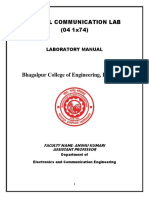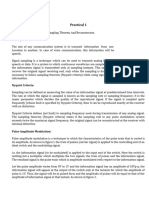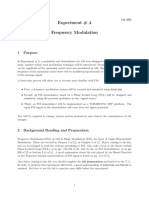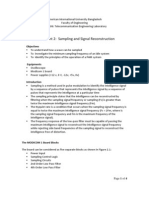0 ratings0% found this document useful (0 votes)
48 views27 pagesPec Lab
Uploaded by
RohitCopyright
© © All Rights Reserved
We take content rights seriously. If you suspect this is your content, claim it here.
Available Formats
Download as PDF or read online on Scribd
0 ratings0% found this document useful (0 votes)
48 views27 pagesPec Lab
Uploaded by
RohitCopyright
© © All Rights Reserved
We take content rights seriously. If you suspect this is your content, claim it here.
Available Formats
Download as PDF or read online on Scribd
You are on page 1/ 27
On: AI
°LING AND RECONSTRUCTION KIT
EXPERIMENT No:1
NAME
Analog Signal Sampling And Reconstruction
OBJECTIVE
To study different types of signal samplings and its reconstruction
1) Natural Sampling,
2) Sample and Hold,
3) Flat top sampling.
THEORY
The kit is used to study Analog Signal Sampling and its Reconstruction. It basically
consists of functional blocks, namely Function Generator, Sampling Control Logic, Clock
section, Sampling Circuitry and Filter Section.
Function Generator
This Block generates two sine wave signals of 1 KHz and 2 KHz frequency. This sine
wave generation is done by feeding 16 KHz and 32 KHz clock to the shift register. The
serial to parallel shift register with the resistive ladder network at the output generates 1
KHz and 2 KHz sine waves respectively by the serial shift operation. The R-C active filter
suppresses the ripple and smoothness the sine wave. The unity gain amplifier buffer takes
care of the impedance matching between sine wave generation and sampling circuit.
Sampling Control Logic
This unit generates two main signals used in the study of Sampling Theorem, namely the
analog signals (5V pp, frequency 1KHz and 2KHz) & sampling signal of frequency 2KHz,
4KHz, 8KHz, 16KHz, 32KHz, and 64KHz.
The 6.4 MHz Crystal Oscillator generates the 6.4 MHz clock. The decade counter divides
the frequency by 10 and the ripple counter generates the basic sampling frequencies from
2 KHz to 64KH7z and the other control frequencies.
From among the various available sampling frequencies, required sampling frequency is
selected by using the Frequency selectable switch. The selected sampling frequency is
indicated by means of corresponding LED.
Clock Section ae
This section facilitates the user to have his choice of external or internal clock feeding to
the sampling section by using a switch (SW4).
Sampling Circuitry ae” a
The unit has three parts namely, Natural Sampling Circuit, Flat top Sampling Circuit, and
Sample and Hold Circuit. ;
The Natural sampling section takes’ sine wave as analog input and samples the analog
input at the rate equal to the sampling signal.
DCL-01: ANALOG SIGNAL SAMPLING AND RECONSTRUCTION KIT v-17.0
For sample and hold circuit, the output is taken across a capacitor, which holds the level of
the samples until the next sample arrives.
For flat top sampling clock used is inverted to that of sample & hold circuit. Output of flat
top sampling circuit is pulses with flat top and top corresponds to the level of analog signal
at the instant of rising edge of the clock signal.
Filter Section
Two types of Filters are provided on board, viz., 2" Order and 4th Order Low Pass
Butterworth Filter.
EQUIPMENTS
Experimenter kit DCL -01.
Connecting Chords
Power supply
20 MHz Dual Trace Oscilloscope
NOTE: Keep All the Switch Faults (Except Switch 1) In Off Position
PROCEDURE
1) Natural Sampling And Its Reconstruction
4. Refer to the Block Diagram (Fig. 1.1) & Carry out the following connections and
switch settings.
2. Connect power supply in proper polarity to the kit DCL-01 & switch it on.
3. Connect the 1 KHz, 5Vpp Sine wave signal, generated on board; to the BUF IN
post of the BUFFER and BUF OUT post of the BUFFER to the IN post of the
Natural Sampling block by means of the Connecting chords provided.
4. Connect the sampling frequency clock in the internal mode INT CLK using switch
(sW4).
Using clock selector switch (S1) select 8 KHz sampling frequency.
. Using switch SW2 select 50% duty cycle. a
. Connect the OUT post of the Natural sampling block to the input IN1 post of the 2
Order Low Pass Butterworth Filter and take necessary observation as mentioned
below. (Fig. 1.4)
8. Repeat the procedure for the 2 KHz sine wave signal as input.
Noa
DCL-01: ANALOG SIGNAL SAMPLING AND RECONSTRUCTION KIT v-17.0
OBSERVATIONS
Observe the following waveforms in order for every setting and plot it on the paper.
a. Analog Input waveform.
b. Sampling frequency waveform. :
c. Natural sampling signal and its corresponding reconstructed output of 2" order Low
Pass Butterworth Filter.
SWITCH FAULTS
Note: Keep the connections as per the procedure. Now switch corresponding fault switch
button in ON condition & observe the different effect on the output. The faults are
normally used one at a time.
. Put switch 6 of SF2 in Switch Fault section to ON position. This will open B1 bit
from the B input (4-bit DIP switch output) of the comparator. This introduces the
fault in duty cycle section. With effect, change in duty cycle for settings (10%, 40%,
50%, 80% and 90%) will not be observed as expected.
. Put switch 7 of SF2 in Switch Fault section to ON position. This will open the
bypass capacitor of the 2™ order low pass butter-worth filter, which results in the
induction of ripples at the filter output.
. Put switch 8 of SF2 in Switch Fault section to ON position. This Removes the
capacitor (C6) used in the generation of 1 KHz sine wave. Which makes the sine
wave signal very distorted. The Observation can be made on this signal by
changing the sampling frequencies and the duty cycle.
PROCEDURE
2) Sample And Hold And Its Reconstruction
fi Refer to the Block Diagram (Fig. 1.2) & Carry out the following corinections and
switch settings.
Connect power supply in proper polarity to the kit DCL-01 & switch it on.
Connect the 1 KHz, 5Vpp Sine wave signal, generated onboard, to the BUF IN post
of the BUFFER and the BUF OUT post of the BUFFER to the IN post of the Sample
and Hold Block by means of the Connecting chords provided.
4. Connect the sampling frequency clock in the internal mode INT CLK using switch
(SW4).
Using clock selector switch SW1 select 8 KHz sampling frequency.
Using switch SW2 select 50% duty cycle. :
Connect the OUT post of the Sample and Hold block to the input IN 1 post of the
2" Order Low Pass Butterworth Filter and take necessary observation as
mentioned below. (Fig. 1.5)
8. Repeat the procedure for the 2 KHz sine wave signal as input.
eon
oct
FUNGTION
GENERATOR
FIG.1.1 BLOCK DIAGRAM FOR NATURAL SAMPLING
1234 5678
SWITCH FAULTS SELECTION SWITCH
SAMPLING GLOK
DUTY CYCLE SELECTION SWITCH
DCL-01: ANALOG SIGNAL SAMPLING AND RECONSTRUCTION KIT V-17.0
OBSERVATIONS
Observe the following waveforms in order for every setting and plot it on the paper.
a. Analog Input waveform.
b. Sampling frequency waveform.
iC Natural sampling signal and its corresponding reconstructed output of 2" order Low
Pass Butterworth Filter.
v-17.0
DCL-01; ANALOG SIGNAL SAMPLING AND RECONSTRUCTION KIT
= INPUT SIGNAL {KHz ‘SVpp |
NE
CLOCK 8KHz, DUTY CYCLE 50s
gl gy
NATURAL SAMPLING OUTPUT
a
Nagel
FILTER OUTPUT OUTi
FIG.1.4 WAVEFORMS NATURAL SAMPLING :
ecce
Sees
555
i : WOLIMS NOLLOATAS SLIMY HOLLINS
pect
wu
womuaLing
#2000
NUE
ino no aw
‘WOLVUINIG NOLLINAS
‘AQNINOWA
‘ONITdWYS
MABIO
61.08: PAM PHIM PI
08: PAM/ PWM / PPM MODULATION & DEMODULATION Kir “varo
EXPERIMENT NO.
NAME
Pulse Amplitude Modulation.
OBJECTIVE
Study of Pulse Amplitude Modulation & Demodulation
THEORY
In Pulse Amplitude Modulation, the signal is sampled at regular intervals and the
amplitude of each sample is made proportional to the amplitude of the signal at that instant
of sampling. This amplitude of each sample is hold for the sample duration to make pulses
flat top.
The Pulse Amplitude Demodulator consists of Active Low Pass Butterworth filter. It filters
out the sampling frequency and their harmonics from the modulated signal and recovers
the base band by integrated action.
EQUIPMENTS
Experimenter kit DCL-08.
Connecting Chords
Power supply
20 MHz Dual trace oscilloscope
NOTE: Keep The Switch Faults In Off Position.
PROCEDURE
Refer to the block diagram (Fig. 1) and carry out the following connections and
switch settings.
Connect the Power Supply with proper polarity to the kit DCL-08 and switch it on.
Select 16KHz sampling frequency by jumper JP1.
Connect the 1KHz, 2Vp-p sine wave signal generated onboard to PAM IN Post.
Observe the Pulse Amplitude Modulation output at PAM OUT Post.
Short the following posts with the Connecting chords provided as shown in block
diagram.
PAM OUT and AMP IN
AMP OUT and FIL IN
Keep the amplifier gain control potentiometer PS to maximum completely clockwise.
Observe the Pulse Amplitude Demodulated signal at FIL OUT, which is same as
the input signal
Repeat the experiment for different input signal and sampling frequencies.
1
OPARON
INPUT SIGNAL 1 1KH2,2Vpp |
CLOCK 16KHz
ill Wt | na (Muu. ail
penne ourpur |
gama a é ana
p 2 260uS FIG.1.2 PAM WAVEFORMS
5 vy 250
{in
PAM OUTPUT 4
sila. vil
ee oe
FILTER OUTPUT
2 260 |
) 2V 260us
B24, 250us |, nelle Lekota dene aioe uci alae ete ena
|
vara
DCL-08: PAM/ PWM / PPM MODULATION & DEMODULATION KIT.
WOLUNS NOLLOTTAS S1Inva HOLIMS
wornnoouaa
NowIsod
asind
muons
asin
wn
iwonwauing
00
wouinao
Nt
wOLVUIN39 NOWLONM.
;
‘
S
“
S
a
“|
DIGITAL COMMUNICATION
CI-08: PAM / PWM /
"MODULATION & DEMODULATION kIT v170
EXPERIMENT NO: 2
NAME
Pulse Width Modulation.
OBJECTIVE
Study of Pulse Width Modulation and Demodulation
THEORY
Pulse Width Modulation
This technique of modulation controls the variation of duty cycle of the square wave (With
some fundamental frequency) according to the input modulating signal. Here the
amplitude variation of the modulation signal is reflected in the ON period variation of
square wave. Hence, itis a technique of V to T conversion
Pulse Width Demodulation
The input signal is Pulse Width Modulated, so the ON time of the signal is changing
according to the modulating signal. In this demodulation technique during the ON time of
PWM signal one counter is enabled. At the end of ON time, counter gives a particular
count, which directly corresponds to the amplitude of input signal. Then this count is fed to
a DAC. The output of DAC corresponds to the amplitude of input signal. Thus train of
varying pulse widths gives varying count values and accordingly DAC give outputs, which
is directly proportional to amplitude of input signal. This is then filtered to get original
signal. Thus at the output we get the original modulating signal extracted from PWM wave.
EQUIPMENTS
Experimenter kit DCL-08.
Connecting Chords
Power supply
20 MHz Dual trace oscilloscope
NOTE: Keep The Switch Faults In Off Position.
PROCEDURE
1 Refer to the block diagram (Fig. 2)
) and carry out the following connections and
switch settings.
2. Connect the Power Supply with proper polarity to the kit DCL-08 and switch it on
3. Put jumper JP3 to 2™ position.
4, Select 1KHZ 1v-pp sine wave signal generated onboard.
5. Connect this signal to PWM/PPM IN.
RETA
<2 DIGITAL COMMUNICATION
DCL-08: PAM / PWM / PPM MODULATION & DEMODULATION KIT. V-17.0,
6.
Observe the Pulse Width Modulated output at PWM OUT post. Note that since the
sampling frequency is high, only blurred band in waveform will be observed due to
persistence of vision. In absence of input signal only square wave of fundamental
frequency and fixed on time will be observed and no width variation are present. To
observe the variation in pulse width, apply 1-30Hz sine wave signal to PWM/PPM
IN post. Vary the frequency from 1-30 Hz.
Short the following posts with the Connecting chords provided as shown in block
diagram for demodulation section.
PWM OUT and BUF IN
BUF OUT and PWM DMOD IN
DMOD OUT and FIL IN
Observe the Pulse Width Demodulated output at FIL OUT.
Repeat the experiment for different input signal and different sampling clocks with
the help of jumper JP3.
Procedure for Observation of PWM output in DUAL mode:
Keep CH1 knob of CRO on 1 Volt/ div ac.
Keep CH2 knob of CRO on 2 Volts/ div ac.
Keep Times/ div knob on 1 msec.
Keep the CRO in Dual channel (Auto/ TV mode). Use X10 for expansion.
After proper triggering of CRO, observe both the signals PWM IN and PWM OUT
simultaneously.
—- ——— 1
PRR PEP
Peeper per
pe Et ay
ec cis poe ™
INPUT SIGNAL 1KHz,1Vpp -
ame! US ILI ANNIUANANOULRUL
PWM OUTPUT
me LUTEUM UCR
BUFFER OUTPUT
PYM DEMOD OUTPUT
rat ames
eer
a ae eciaae
E gg eal 4
FILTER OUTPUT
) soomv awous FIG.2.2 PWM WAVEFORMS
5. 100uS
) 5 ¥ -100.uS.
) 500 mmi¥ 100 us
yh $00 mY, 400 WS 1 1 1 L J
Ji
HALIMS NOLLOITAS SLINVE HOLS
So ioeae) pez
voivnoowia | 100
cows NTH
WH
HLYOMEILIN
WOU 4
NIgOW3a NIN Ano Wad
wouvingon
NOLLISOd
asind
HHLOL
isind
WOLVWINIS NOLLINMY
ATION Ki
DCL.08: PAM/ PWM /PPM MODULATION & C
EXPERIMENT NO: 3
NAME
Pulse Position Modulation.
OBJECTIVE
Study of Pulse Position Modulation and Demodulation
THEORY
The position of the TTL pulse is changed on time scale according to the variation of input
modulating signal amplitude, Width of the pulses and Amplitude of the pulses remain
same.
Demodulation
This pulse position modulated signal is converted into PWM pulse form using Monosatable
multivibrator. This signal is then demodulated using the same technique of PWM
demodulation. In this demodulation technique during the ON time of PWM signal one
counter is enabled. At the end of ON time, counter gives a particular count, which directly
corresponds to the amplitude of input signal. Then this count is fed to a DAC. The output
of DAC corresponds to the amplitude of input signal. Thus train of varying pulse widths
gives varying count values and accordingly DAC gives outputs, which is directly
proportional to amplitude of input signal. This is then filtered to get original signal. Thus at
the output we get the original modulating signal extracted from PWM wave.
EQUIPMENTS
Experimenter kit DCL-08
Connecting Chords
Power supply
20 MHz Dual trace oscilloscope
NOTE: Keep The Switch Faults In Off Position.
PROCEDURE
1 Refer to the block diagram (Fig. 3) and carry out the following connections and
switch settings.
Connect the Power Supply with proper polarity to the kit DCL-08 and switch it on.
Put jumper JP3 to 2™ position.
Select 1KHZ, 1v-pp sine wave signal generated onboard
Connect the selected signal to the PWM/PPM IN.
ARON
Ream) “8 DyGITAL COMMUNICATION
DCL-08: PAM / PWM/ PPM MODULATION & DEMODULATION KIT V-A7.0
6.
Observe the Pulse Position Modulated output at PPM OUT post with shifted
position on time scale. Please note amplitude and width of pulse are same and
there is shift in position which is proportional to input Analog signal.
To observe the variation in pulse positions, apply 1-30Hz sine wave signal to
PWM/PPM IN post vary the frequency from 1-30 Hz and observe the signal on
Oscilloscope in dual for posts PPM OUT and PWM OUT simultaneously.
Then short the following posts with the link provided as shown in block diagram for
Demodulation section.
PPM OUT and BUFIN
BUFOUT and PPM DMOD IN
DMOD OUT and FIL IN
Observe the Pulse Position Demodulated signal at FIL OUT.
Repeat the experiment at different input signal and different sampling frequencies.
ULI JUN
a {{UUWLEL HL LL i
ACL-03: FREQU
x IENCY MODUL
ATION TRANSMITTER KIT & ACL-04: FREQUENCY DEMODULATION RECEIVER KIT V-2
uaa fod. 3 eo
NAM /
\) STUDY OF FREQUENCY MODULATION.
OBJECTIVE:
7x
5 Tg Plot the modulation characteristic of varactor modulator
© calculate the modulation sensitivity of varactor modulator.
A A Observe and measure frequency deviation and modulation index of FM.
*, To study frequency modulation using reactance modulator and measure the
frequency deviation
/AHEORY: *
Mb FREQUENCY MODULATION
wai is a type of modulation in which the frequency of the high frequency (Carrier) is
ried in accordance with the instantaneous value of the modulating signal ) aD
yy 12 MAIN ASPECTS
Consider a sine wave signal vm(t) with pulse w (FIG. 1.1)
vmn(t) = B+ sin(wet)
and another sine wave ve(t) with upper © pulse:
Volt) = A + sin(-t)
The signal v(t) is called modulating signal, the signal ve(t) is called carrier signal.
Vary the frequency of the carrier ve(t) in a way proportional to the amplitude of the
modulating signal vm(t). You obtain a v(t) frequency modulated diagonal, which can
be expressed by the relation:
vin(t) = A+ sin [0(¢t)]
with @(t) instantaneous angle function of v(t).
4.3 MATHEMATICAL EXPRESSION OF THE FREQUENCY MODULATED
/ SIGNAL
The instantaneous pulse {(t) of the FM signal by definition:
ft) = 0+ Ke vin(t)
with Q = carrier pulse
K= modulation sensitivity
ALOG COMMUNICATION
area ‘ANALOG ro}
|
Re.
ACLS FREQUENCY MODULATION TRANSMITTER KIT& AGL-Of: FREQUENCY DEMODLLATION RECENVERKIT_V-2
The instantaneous angle © (t) to be used as subject of the sine to obtain the
mathematical operation of the FM signal, is detected by integrating Q (t):
o(t) = Jom at
In the case of modulating sine wave signal [vm (t) = B.sin (w.t)], 6 (t) it results:
O(t) = Qe (t) — (K-B/w) + cos(w-t)
The expression of the frequency modulated signal vm (t) becomes:
¥.) ore v(t) = A + sin[Qs (t)- (K*B/w) * cos(wet)]
: 3 REQUENCY DEVIATION AF AND MODULATION INDEX Mr
The instantaneous frequency F(\) of the carrier modulated by a sine wave, results
F(t) = Olt) = © + K-Besin(wet)
2x 2x
and oscillates between a minimum Fmin and a maximum-value Fmax
Frm KB
RUA Qn 2x 2n 2x x
Ms frequency deviation AF represents the maximum shift between the modulated
signal frequency, over and under the frequency of the carrier:
AF = Fmax—Fmin
2
We define as modulation index mi the ratio between AF and the modulating
frequency f:
mr=Ae \ / fe
FREQUENCY MODULATION GENERATION:
Thecircuits used to generate a frequency modulation must vary the frequency of a
high frequency signal (carrier) as function of the amplitude of a low frequency signal
(modulating signal). In practice there are two main methods used to generate the FI
kaos DIRECT METHOD
An oscilloscope is used in which the reactance of one of the elements of the resonant
circuit depends on the modulating voltage. The most common device with variable
reactance is the Varactor or Varicap, which is a particular diode which capacity varies
as function of the reverse bias voltage (the Varicap is described in the next chapter).
FALCON -9- ~~ ANALOG COMMUNICATION LAB
Ar= QURINL Ve tZoMV TOM WHICH. OO = QUIIZ90 = U4 ARIZ! MV.
TO OBSERVE i MEASURE FREQUENCY DEVIATION AND
MODULATION INDEX OF FM. }
ae
Modules ACL-03.
Power Supply.
Oscilloscope.
Volt meter.
Frequency meter.
Connecting Links.
Function Generator
NOTE : KEEP ALL THE SWITCH FAULTS IN OFF POSITION.
Te ‘
PROCEDURE:
1.
iz
3.
4.
Refer to the FIG.1.9 & Carry out the following connections.
Connect the power supply with proper polarity to the kit ACL-O3 while
connecting this; ensure that the power supply is OFF.
Connect the o/p of function generator OUT post to the modulation IN of
FREQUENCY MODULATOR MOD IN post.
Switch ON the power supply and Carry out the following presetting:
. FUNCTION GENERATOR: sine wave (JP1); LEVEL about 100m\V;
FREQ. about 1KHz.
FALCON Zs -15- ANALOG COMMUNICATION LAB
ACL-03: FREQUENCY MODULATION TRANSMITTER KIT & ACL-04: FREQUENCY DEMODULATION RECEIVER KIT _V-2
e FREQUENCY MODULATOR LEVEL about 2Vpp; FREQ. on the
center; switch on 1500KHz.
5. Connect the oscilloscope to the output of the modulator FM/RF OUT. You
obtain a waveform similar to the one of FIG. 1.10.
6. The frequency deviation A F can be calculated as follows (refer to FIG. 1.11):
~~ From the oscilloscope evaluate Fu and Fm, detecting the periods of the
respective sine waves
/e The frequency deviation AF is defined as: AF= (Fu—Fm)/2
You can note that if the modulator operates in a linear zone so Fu and Fm are
over and under the central frequency F of the same quantity AF, otherwise this
doés not occur.
St The value of the modulation index mris calculated by the relation
mf = AF/f, where f is the frequency of the modulating signal.
Then observe the FM signal as shown in FIG. 1.10.
To observe the FM at lower frequencies apply Sine wave of 1KHz and 1Vpp
from external function generator to MOD IN post of onboard Function
Generator and keep JP4 at 10-100KHz position and adjust the frequency at
about 20-25KHz and output level of Function generator at 2Vpp. )
Ceci pa
ae
ge 2
oo
Smsictv
‘wid
|| act-03
MODULATING SIGNAL
NVM
“FREQUENCY MODULATED oUTPUT 4 R
f FIG.1.13 FREQUENCY MODULATION
) 1 250us
FALCON -17- "ANALOG COMMUNICATION LAB
INSTRUCTION MANUAL,
(amputuve MODULATION AND DEMODULATION )
(cezerve
(. ie Construct amplitude Modulator using transistor and to demonstrate
OW i
_ Much intelligence can be added, to a carrier and observe the
amplitude modulated waveforms and check the % of modulation,
2 To demonstrate how
Modulated
namely RF
INTRODUCTION
intelligence can be recovered from an amplitude -
cartier by using diode demodulator. It has got three parts
Oscillator, AM modulator and AM demodulator
MODULATION TECHNIQUES
Communication Is defined as a process by which information is exchanged. In
Electronics, it is the transmission ari reception of information. Likewise,
"formation is defined as "the communication of knowledge or intelligence". For
he Purposes of this course, itis defined! as any electrical signal representing data.
Thus, the purpose of any communications systems is 1 convey or transfer
information from one point to another.)
INFORMATION TRANSFER
Our most fundamental methods of transfering information are speech and,
asin this case writing. Communication of the written wor from—
~——. ..hand-carriedeiters-and-newspapers to the mail system, telegraph, and now
electronic mail. Spoken communi cations evolved from face-to-face contact Into
~ felephone and radio communication. Allof these steps were taken in an effort to
increase the communications distance and speed, a
The most significant advance in increasing communications range was radio. e
Basically, the audio or Sound waves are converted to an electrical signal then inte
audio waves and transmitted to a distant receiving station. However, it the audia
signal is transmitted at its original frequency, a number of problems present
themselves. First to be etficient, the transmitting antenna must beat least. 1/4 to
1/2. wavelength long. This means that for a 3000 Hz signal, the antenna problem
was solved, Gnly one station could transmit at a time. This is because all stations
be operating on the same ‘audio" frequencies. And third, transmission
‘system at these frequencies are very inefficient.
All of these problems can. solved by using a higher frequency signal as a
“carrier* for, Ads ODL ETS eS
8 much higher frequency for transmission, then converted back to audio trequen.
former is called
ES OF MODULATION
F Since, three characteristics of the sine wave carrier can be varied, it follows that
frosnent®, {22 types of modulation. These are amplitude modulation (AM),
@quency modulation (FM), and phase modulation (PM). However, in practice, it
a Fie! difficult to distinguish between phase and frequency modulation. Therefore,
; ve types of modulation are grouped together under the title of Angle
Hodulation. Thus, there are two basic types of modulation: Amplitude and Angle.
8 Next section will discuss both of these in detail
DULATION
4a Inthe Process of modulation, some characteristic of a high frequency sine wave
IS varied in accordance with the information or modulation signal. This signal may
_ be an audio wavetorm, a digital pulse train, a television, picture or any other form
Of information. The important consideration is that it is transfered to a higher
frequency for efficient transmission.
AS mentioned before, the modulated high frequency sine wave is called the
carrier. The mathematical expression for an unmodulated sine wave or carrier is
€=Asin(wi ty)
where
A = maximum amplitude a
w = angular velocity (2.x f)
t= time
y = phase angle a
—This equatlor’shows that there are characteristics of the wave that can be varied
or modulated. These are : amplitude (A), angular velocity or frequency (w), and
phase angle (p )
a [AmPLiTUDE MODULATION )
{ With amplitude modulation, the carrier's amplitude is varied in accordance with
the modulating signal. There are several circuits that accomplish this and they will
be examined. Right now, we wish to limit our discussion to the characteristics of
the modulated wavelorm tse ) “
THE AM WAVEFORM
Figure 1. shows a very simple AM cvcuit, Here a radio frequency carrier is
applied at “A* and the modulating audio tone at *B*. The circuit consists of a
nonlinear davice such as a diode or transistor. The two signals "mix" in this circuit
@ = instantaneous value of the wave (voltage or current)
aaa
and produce the AM waveform show at *C*. Notice that both the negative and
Positive peaks of he output waveform correspond exactly tothe modulating tone's
waveform.
sa
EWC 1 Ferree
ee | aacteory
Toul
Figure 1. The basic method of obteining amplitude modulation.
(me amplitude and frequency of the modulating tone determines the shape of
the output waveform or the modulation envelope) For example,Figure 2-A shows
’ @ high amplitude audio signal. The resultant mOdulated waveform is shown in
Figure 2-8. On the other hand, Figure 2-C shows alow amplitude, higher frequency
audio signal. The modulated waveform is in Figure 2-D. aa
MOCULATING
Stoner
[—
+1
o
°
; ie Vy
Figure 2. Examples of how the modulated wavetorm varies with the modulating signal.
(PERCENT OF MODULATION’)
\ The waveforms of Figure 2-B and Fgure 2-D are said to have dif ferent degrees
of moidulation. The degree of modulation is nor mally expressed as a percentage
from 0 to 100. However, it is also known as the modulation factor which varies
from 0 to 1. An unmodulated carrier like that shown in Figure 3-A has 0% modula
tion. For comparison purposes, let's asuune that the carrier has a peak-to-peak
“amplitude of 40 volts as shown..,
oe is
= \ i
B 1008 !
v tas Bui ov
on ;
\ | ©
ts egies Gu
Eun 20
oy
Figure 3. Measuring the ;percent of modulation.
\ Figure 3-8 shows the same carrier modulated to 100%. Here, the amplitude of
the modulated waveform falls to zero volts for an instant during each eycle of the
Modulating wave. Also, the amplitude increases to 80 volt peak-to-peak once
Curing each cycle of each modulatin Pooalvampntecel
is still ae NG Wave. The average peak-to-peal ip!
7 2
In Figure 3-C the cartier is shown’ modulated to 50%. The peak-to-peak
Samplitude varies trom 60 volts to 20 volte However, the average peak-to-peak
amplitude is stil 40 vols,
The equation for determining the percent of Modulation is
Percent of modulation = £mex=E min 100 ) ;
For example, in Figure 1-9C,
% = x 100
Emax+ Emin
60V.
60V
40V |
80V
% = 05X100 = 50
% =
% =
100
(Generally, it is desirable to keep the percent of modulation high. For a given
transmitter power, a high percent of modlulation will produce a stronger audio tone
in the receiver,)The reason for this can oe visualized from Figure - 4.
moduration "
EAv(vOrE
RECOVERED
AUDIO
Figure 4. The relative amplitude of the recovered audio depends on the
modulation percentage.
You might also like
- Analog Signal Sampling & Reconstruction Kit. ObjectiveNo ratings yetAnalog Signal Sampling & Reconstruction Kit. Objective5 pages
- EEE325 Practical Manual October 2019 Ver-1No ratings yetEEE325 Practical Manual October 2019 Ver-113 pages
- Ec6512 Communication Systems Laboratory Manusl71% (24)Ec6512 Communication Systems Laboratory Manusl86 pages
- Experiment: To Demonstrate The Sampling Operations As A First Step Towards Digitisation of An Analog WavefromNo ratings yetExperiment: To Demonstrate The Sampling Operations As A First Step Towards Digitisation of An Analog Wavefrom15 pages
- Experiment 2: Sampling and Reconstruction Objective100% (1)Experiment 2: Sampling and Reconstruction Objective8 pages
- Digital Communication Lab Manual - UpdatedNo ratings yetDigital Communication Lab Manual - Updated42 pages
- Department of E.C.E.: Digital Communications Lab Manual Autonomous Pvp-12No ratings yetDepartment of E.C.E.: Digital Communications Lab Manual Autonomous Pvp-1257 pages
- Laboratory Manual: Department of Electronics & Telecommunication EngineeringNo ratings yetLaboratory Manual: Department of Electronics & Telecommunication Engineering37 pages
- ECE 4664 Digital Communications Laboratory Lab Experiment # 3 The Sampling TheoremNo ratings yetECE 4664 Digital Communications Laboratory Lab Experiment # 3 The Sampling Theorem7 pages
- Third Year: Practical Work Book For The Course EE-394 Communication SystemNo ratings yetThird Year: Practical Work Book For The Course EE-394 Communication System22 pages
- Experiment 10 Sampling and Reconstruction: 10.1 Antialiasing FilterNo ratings yetExperiment 10 Sampling and Reconstruction: 10.1 Antialiasing Filter16 pages
- Hard Wired Lab Requirements SpecificationNo ratings yetHard Wired Lab Requirements Specification20 pages
- Bapatla Engineering College Digital Communications Lab EC-451No ratings yetBapatla Engineering College Digital Communications Lab EC-45130 pages
- CS EXPERIMENT 11 01012021 095140am 18012021 012709amNo ratings yetCS EXPERIMENT 11 01012021 095140am 18012021 012709am13 pages
- Answer Keys For Electronics Communication Systems by George Kennedypdf0% (1)Answer Keys For Electronics Communication Systems by George Kennedypdf57 pages





























































